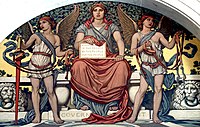
Photo from wikipedia
Abstract Despite their prevalence in the microdata, sales (i.e., temporary price cuts) are often ignored by macroeconomists. If sales are taken into account, price rigidity is small in the data.… Click to show full abstract
Abstract Despite their prevalence in the microdata, sales (i.e., temporary price cuts) are often ignored by macroeconomists. If sales are taken into account, price rigidity is small in the data. Using the microdata underlying the Consumer Price Index (CPI), I first demonstrate that sales of durable goods have a substantial impact on the aggregate price index, and that the price index decreases gradually after these sales. To quantify the changes in the real effects of monetary policy due to sales, I propose a two-sector menu-cost model, in which sales are allowed. The model, which is able to match salient features of the microdata, predicts that the real effects of monetary policy will be significantly overestimated if sales of durable goods are not taken into consideration. Compared to my benchmark model, the model without sales and the Calvo model calibrated to the frequency of regular price changes both generate much greater real effects of monetary policy.
Journal Title: Review of Economic Dynamics
Year Published: 2021
Link to full text (if available)
Share on Social Media: Sign Up to like & get
recommendations!